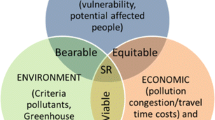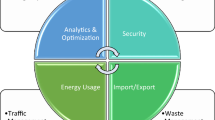Abstract
Eco-routing is a simple yet effective approach to substantially reducing the environmental impact, e.g., fuel consumption and greenhouse gas (GHG) emissions, of vehicular transportation. Eco-routing relies on the ability to reliably quantify the environmental impact of vehicles as they travel in a spatial network. The procedure of quantifying such vehicular impact for road segments of a spatial network is called eco-weight assignment. EcoMark 2.0 proposes a general framework for eco-weight assignment to enable eco-routing. It studies the abilities of six instantaneous and five aggregated models to estimating vehicular environmental impact. In doing so, it utilizes travel information derived from GPS trajectories (i.e., velocities and accelerations) and actual fuel consumption data obtained from vehicles. The framework covers analyses of actual fuel consumption, impact model calibration, and experiments for assessing the utility of the impact models in assigning eco-weights. The application of EcoMark 2.0 indicates that the instantaneous model EMIT and the aggregated model SIDRA-Running are suitable for assigning eco-weights under varying circumstances. In contrast, other instantaneous models should not be used for assigning eco-weights, and other aggregated models can be used for assigning eco-weights under certain circumstances.









Similar content being viewed by others
Notes
References
Energy and climate goals of china’s 12th five-year plan. http://tinyurl.com/73mntqg
Fact sheet: Australia’s emissions reduction targets. http://tinyurl.com/7vpzufx
G8 plans 50 % reduction in greenhouse gases. http://tinyurl.com/68hn2a
CAN Applications. http://www.can-cia.org/index.php?id=30
Squarell CAN bus Reader. http://europe.squarell.com/en/can-bus/
Reducing emissions from transport. http://tinyurl.com/7ex6am3
Road transport: Reducing CO2 emissions from light-duty vehicles. http://tinyurl.com/6gtlzzz
USGS center for LIDAR information coordination and knowledge. http://lidar.cr.usgs.gov/
What is the EU doing on climate change? http://tinyurl.com/75qex2g
The Accuracy of Squarell., http://europe.squarell.com/en/Support/FAQ/faq/117/How-accurate-is-the-fuel-consumption-in-a-CANbus-truck- http://europe.squarell.com/en/Support/FAQ/faq/117/How-accurate-is-the-fuel-consumption-in-a-CANbus-truck-
Mercedes-Benz Sprinter Operator Manuals. http://www.mbsprinterusa.com/files/manuals/2012_Mercedes_Benz_Sprinter_Operators_Manual.pdf
FMS Standard. http://www.fms-standard.com/
Yang B, Guo C, Jensen CS, Kaul M, Shang S (2014) Stochastic skyline route planning under time-varying uncertainty. ICDE:136–147
Yang B, Kaul M, Jensen CS (2014) Using incomplete information for complete weight annotation of road networks. TKDE 26(5):1267–1279
Andersen O, Jensen CS, Torp K, Yang B (2013) EcoTour: reducing the environmental footprint of vehicles using eco-routes. MDM:338–340
Guo C, Yang B, Andersen O, Jensen CS, Torp K EcoSky: reducing vehicular environmental impact through eco-routing, in ICDE, 2015 (to appear)
Kaul M, Yang B, Jensen CS (2013) Building accurate 3D spatial networks to enable next generation intelligent transportation systems. MDM:137–146
Yang B, Guo C, Jensen CS (2013) Travel cost inference from sparse, spatio-temporally correlated time series using markov models. PVLDB 6(9):769–780
Akçelik R, Smit R, Besley M (2012) Calibrating fuel consumption and emission models for modern vehicles. IPENZ transportation group conference. Rotorua, New Zealand
Guo C, Ma Y, Yang B, Jensen CS, Kaul M (2012) EcoMark: evaluating models of vehicular environmental impact. SIGSPATIAL/GIS:269–278
Rakha H, Ahn K, Moran K, Saerens B, Van den Bulck E (2011) Virginia tech comprehensive power-based fuel consumption model: model development and testing. Transp Res Part D: Transp Environ:492–503
Lei W, Chen H, Lu L (2010) Microscopic emission and fuel consumption modeling for light-duty vehicles using portable emission measurement system data. World Acad Sci Eng Technol:918–925
EPA (2010) Technical guidance on the use of MOVES2010 for emission inventory preparation in state implementation plans and transportation conformity. U.S. EPA National Vehicle and Fuel Emissions Laboratory
Hausberger S, Rexeis M, Zallinger M, Luz R (2009) Emission factors from the model PHEM for the HBEFA version 3
Pereira F, Costa H, Pereira N (2009) An off-line map-matching algorithm for incomplete map databases. Eur Transp Res Rev 1(3):107–124
Song G, Yu L, Wang Z (2009) Aggregate fuel consumption model of light-duty vehicles for evaluating effectiveness of traffic management strategies on fuels. J Transp Eng 135:611–618
Tavares G, Zsigraiova Z, Semiao V, Carvalho M (2009) Optimisation of MSW collection routes for minimum fuel consumption using 3D GIS modelling. Waste Manag 29(3):1176–1185
Ahn K, Rakha H (2008) The effects of route choice decisions on vehicle energy consumption and emissions. Transp Res Part D: Transp Environ 13(3):151–167
Kono T, Fushiki T, Asada K, Nakano K (2008) Fuel consumption analysis and prediction model for “eco” route search. In: 15th World congress on intelligent transport systems and ITS America’s 2008 annual meeting
ARB (2007) EMFAC2007 version 2.30: calculating emission inventories for vehicles in California. U.S. the California Air Resources Board
Boulter P, McCrae I, Barlow T (2007) A review of instantaneous emission models for road vehicles. Transport Research Laboratory, Published Project Report 267, Final
EEA (2007) Copert 4 user manual (version 5), computer programme to calculate emissions from road transport. European Environment Agency
Othman HF, Aji YR, Fakhreddin FT, Al-Ali AR (2006) Controller area networks: evolution and applications. In: 2nd Information and Communication Technologies, ICTTA’06, vol 2, pp 3088–3093. IEEE
Scora G, Barth M (2006) Comprehensive Modal Emission Model (CMEM), version 3.01 users guide. University of California Riverside Center for Environmental Research and Technology
Voss W (2005) A comprehensible guide to Controller area network. Copperhill Technologies Corporation
Nam EK, Giannelli R (2005) Fuel consumption modeling of conventional and advanced technology vehicles in the Physical Emission Rate Estimator (PERE). Technical report, U.S. Environmental Protection Agency
Rakha H, Ahn K, Trani A (2004) Development of VT-Micro model for estimating hot stabilized light duty vehicle and truck emissions. Transp Res Part D: Transp Environ 9(1):49–74
Dhir A (2004) The digital consumer technology handbook: a comprehensive guide to devices, standards, future directions, and programmable logic solutions. Newnes (an imprint of Butterworth-Heinemann Ltd)
Pelkmans L, Debal P, Hood T, Hauser G, Delgado M-R (2004) Development of a simulation tool to calculate fuel consumption and emissions of vehicles operating in dynamic conditions. SAE
Rakha H, Ahn K, Trani A (2003) Comparison of MOBILE5a, MOBILE6, VT-MICRO, and CMEM models for estimating hot-stabilized light-duty gasoline vehicle emissions. Can J Civil Eng 30(6):1010–1021
Teng H, Yu L, Qi Y (2002) Statistical microscale emission models incorporating acceleration and deceleration. In: 81st transportation research board annual meeting
Ahn K, Rakha H, Trani A, Van Aerde M (2002) Estimating vehicle fuel consumption and emissions based on instantaneous speed and acceleration levels. J Transp Eng 128(2):182–190
Cappiello A (2002) Modeling traffic flow emissions. Master’s thesis, Massachusetts Institute of Technology
Cappiello A, Chabini I, Nam E K, Lue A, Zeid MA (2002) A statistical model of vehicle emissions and fuel consumption. In: The IEEE 5th international conference on intelligent transportation systems, pp 801–809
EPA (2001) User’s guide to MOBILE6, mobile source emission factor model. U.S. EPA National Vehicle and Fuel Emissions Laboratory
Ntziachristos L, Samaras Z, Agency EE (2000) COPERT III Computer programme to calculate emissions from road transport: methodology and emission factors (version 2.1). Eur Environ Agency
Joumard R et al (1999) Methods of estimation of atmospheric emissions from transport: European scientist network and scientific state-of-the-art. INRETS report LTE, 9901
Hickman J, Hassel D, Joumard R, Samaras Z, Sorenson S (1999) Methodology for calculating transport emissions and energy consumption. TRL Report SE/491/98: Deliverable for EU project MEET
Jiménez-Palacios JL (1998) Understanding and quantifying motor vehicle emissions with vehicle specific power and TILDAS remote sensing. PhD thesis, Massachusetts Institute of Technology
Joumard R, Jost P, Hickman J, Hassel D (1995) Hot passenger car emissions modelling as a function of instantaneous speed and acceleration. Sci Total Environ 169:167–174
Bowyer D, Akċelik R, Biggs D, A. R. R. Board (1985) Guide to fuel consumption analyses for urban traffic management. Technical report, Australian Road Research Board
Dijkstra E (1959) A note on two problems in connexion with graphs. Numerische mathematik 1(1):269–271
Acknowledgments
This work was supported in part by the Reduction project that is funded by the European Commission as FP7-ICT-2011-7 STREP project number 288254 and in part by the InfinIT Project www.infinit.dk.
Author information
Authors and Affiliations
Corresponding author
Rights and permissions
About this article
Cite this article
Guo, C., Yang, B., Andersen, O. et al. EcoMark 2.0: empowering eco-routing with vehicular environmental models and actual vehicle fuel consumption data. Geoinformatica 19, 567–599 (2015). https://doi.org/10.1007/s10707-014-0221-7
Received:
Revised:
Accepted:
Published:
Issue Date:
DOI: https://doi.org/10.1007/s10707-014-0221-7




